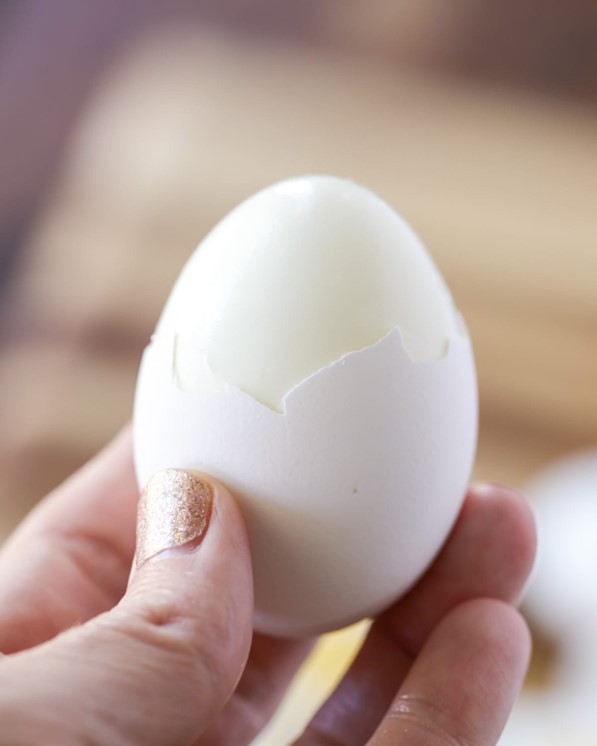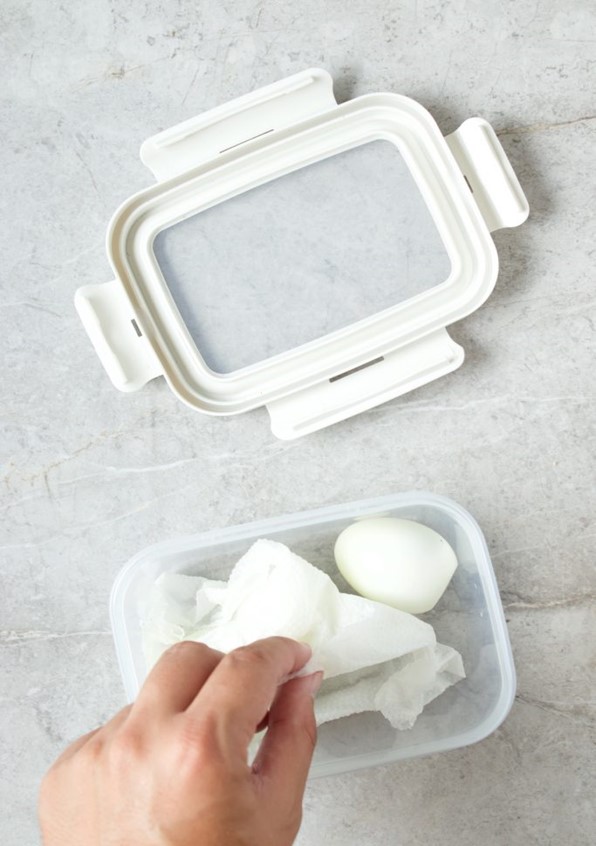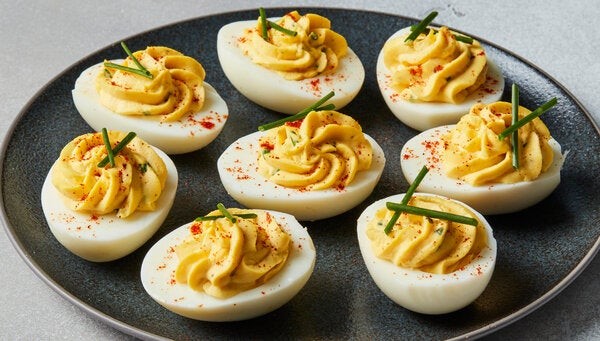Did You Know There’s A RIGHT WAY to Storing Hard-Boiled Eggs?
Recently Madeline Buiano, researcher and staff writer for Martha Stewart, reported on the DOs and DON’Ts of storing hard-boiled eggs (according to food safety experts).

Don’t we love our hard-boiled eggs? Whether served as a snack, salad topping, or fuss-free breakfast, they’re great for a quick protein boost and don't require much work to make. Around our house we like to cook up a batch and nosh on them throughout the week.
Turns out though, there’s a right and wrong way to do that. To maintain their freshness, they need to be stored properly. Using the right technique, hard-boiled eggs can stay fresh for up to a week. According to Madeline’s research, “the right technique” isn’t rocket science, but it is precise.

First of all, the eggs need to completely cool before you place them in the refrigerator. "When hot items are placed in the refrigerator, they can warm up other surrounding items, placing them in the temperature danger zone where bacteria like to multiply," says Tracey Brigman, EdD, MS, RDN, LD, a clinical associate professor and associate director for National Center for Home Food Preservation at the University of Georgia.
To speed the cooling process, simply place the eggs in cold water or an ice bath for a few minutes. Once cool, they’re also easier to handle—peeling goes quicker.

Once peeled, the eggs should be stored in an airtight bag or container. "Since they are peeled, they need to be protected from exposure to air, odors, and any microorganisms that may be present," Brigman says. She adds that you should place a damp paper towel inside the container to prevent them from drying out. (The added paper towel is the step I’ve been leaving out!)
You’ll want to keep hard-cooked eggs on the middle shelf of your refrigerator (where the temperature is most stable) until you're ready to eat them.

Do the same for unpeeled hard-boiled eggs as well. They also should be kept on the refrigerator’s middle shelf in an airtight container or resealable bag. "During the cooking process, the protective layer that coats the shell is removed, making the eggs more susceptible to air and harmful microorganisms," Brigman explains. However, you can skip adding a paper towel to the container to prevent moisture loss as the eggs still have their shells intact.

Now here’s what to know to extend their shelf life and keep yourself safe from unwanted bacteria. There are a couple things NOT TO DO:
Finally, if your hard-boiled eggs develop a slimy or chalky texture, or if they develop an unmistakable odor, they should be discarded. Common sense, right?
I’ll close this hard-boiled egg tutorial with a “THANK YOU!” to Madeline for her succinct summation, and a favorite recipe for one of the best deviled eggs you’ll ever eat. This recipe comes from the New York Times Cooking section, and has 2.8 thousand 5-Star reviews. I think it’s the smidge of Tabasco sauce that makes the difference. See what you think:

6 large eggs
1 teaspoon Dijon style mustard
1 to 2 dashes Tabasco sauce to taste
salt to taste
1/4 teaspoon freshly ground black pepper
1 tablespoon snipped, fresh chives
3 tablespoons mayonnaise
smoked paprika for garnish
whole, fresh chives for garnish
Directions:
Add Recipe to Cook'n
blog comments powered by Disqus

Don’t we love our hard-boiled eggs? Whether served as a snack, salad topping, or fuss-free breakfast, they’re great for a quick protein boost and don't require much work to make. Around our house we like to cook up a batch and nosh on them throughout the week.
Turns out though, there’s a right and wrong way to do that. To maintain their freshness, they need to be stored properly. Using the right technique, hard-boiled eggs can stay fresh for up to a week. According to Madeline’s research, “the right technique” isn’t rocket science, but it is precise.

First of all, the eggs need to completely cool before you place them in the refrigerator. "When hot items are placed in the refrigerator, they can warm up other surrounding items, placing them in the temperature danger zone where bacteria like to multiply," says Tracey Brigman, EdD, MS, RDN, LD, a clinical associate professor and associate director for National Center for Home Food Preservation at the University of Georgia.
To speed the cooling process, simply place the eggs in cold water or an ice bath for a few minutes. Once cool, they’re also easier to handle—peeling goes quicker.

Once peeled, the eggs should be stored in an airtight bag or container. "Since they are peeled, they need to be protected from exposure to air, odors, and any microorganisms that may be present," Brigman says. She adds that you should place a damp paper towel inside the container to prevent them from drying out. (The added paper towel is the step I’ve been leaving out!)
You’ll want to keep hard-cooked eggs on the middle shelf of your refrigerator (where the temperature is most stable) until you're ready to eat them.

Do the same for unpeeled hard-boiled eggs as well. They also should be kept on the refrigerator’s middle shelf in an airtight container or resealable bag. "During the cooking process, the protective layer that coats the shell is removed, making the eggs more susceptible to air and harmful microorganisms," Brigman explains. However, you can skip adding a paper towel to the container to prevent moisture loss as the eggs still have their shells intact.

Now here’s what to know to extend their shelf life and keep yourself safe from unwanted bacteria. There are a couple things NOT TO DO:
- DO NOT leaves your eggs at room temperature for more than two hours. Longer, and they start to spoil and potentially harmful bacteria starts to spread.
- DO NOT store hard cooked eggs in the freezer. Once defrosted, the egg white will turn tough with a watery texture and become inedible.
Finally, if your hard-boiled eggs develop a slimy or chalky texture, or if they develop an unmistakable odor, they should be discarded. Common sense, right?
I’ll close this hard-boiled egg tutorial with a “THANK YOU!” to Madeline for her succinct summation, and a favorite recipe for one of the best deviled eggs you’ll ever eat. This recipe comes from the New York Times Cooking section, and has 2.8 thousand 5-Star reviews. I think it’s the smidge of Tabasco sauce that makes the difference. See what you think:

Classic Hard-Boiled Eggs
Yield: 12 halves
Ingredients:
6 large eggs
1 teaspoon Dijon style mustard
1 to 2 dashes Tabasco sauce to taste
salt to taste
1/4 teaspoon freshly ground black pepper
1 tablespoon snipped, fresh chives
3 tablespoons mayonnaise
smoked paprika for garnish
whole, fresh chives for garnish
Directions:
1. Rinse eggs with warm water, and place in a small saucepan. Cover with cold water, place the pan over medium-high heat and bring to a boil. Turn off heat, cover and let sit for 10-12 minutes. Drain, rinse under cold water and peel. Cool in the refrigerator, loosely covered, for 15 minutes.
2. Halve eggs lengthwise, and carefully scoop out yolks. Place yolks in a bowl, and mash with a fork. Add mustard, Tabasco, salt, pepper and snipped chives. Stir in mayonnaise.
3. Fill each egg white with about 1½ teaspoons of the egg-yolk mixture and dust the top with paprika. Arrange in a spoke design on a platter; garnish with whole chives.
2. Halve eggs lengthwise, and carefully scoop out yolks. Place yolks in a bowl, and mash with a fork. Add mustard, Tabasco, salt, pepper and snipped chives. Stir in mayonnaise.
3. Fill each egg white with about 1½ teaspoons of the egg-yolk mixture and dust the top with paprika. Arrange in a spoke design on a platter; garnish with whole chives.
Recipe formatted with the Cook'n Recipe Software from DVO Enterprises.
 Alice Osborne
Alice Osborne
DVO Newsletter Contributor since 2006
Email the author! alice@dvo.com
Sources:
- www.onceuponachef.com
- www.lilluna.com
- www.thespruceeats.com
- www.pantryandlarder.com
- www.eggs.ca
- www.cooking.nytimes.com
